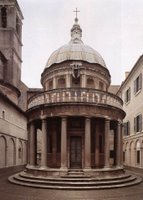On the Importance of Dates in Art Appreciation
I know how irritating it can be when someone reviews something I've written, but misrepresents or didn't quite understand a point I made. So I want to share a portion of the e-mail I received from Rob Burdock, the blogger whose "embedded dates" technique I last wrote about.
Rob wrote: "Perhaps I wrongly give the impression that my reason for devising this system for remembering dates was due to a real need to regurgitate an artwork's date during an Art History test. While this may earn an extra point the real reason for devising this system was so I could place the piece into the correct context with other creations of the same period. When I first began studying the subject my lack of Art History knowledge and my inability to remember dates resulted in me quite easily visualising Giotto skipping hand in hand through the streets of Florence with da Vinci or Bernini telling Michelangelo that his David was frankly a bit of rubbish! (Bernini's words, not mine) so being able to accurately date artwork was important for me to understand artist's influences, contemporary conventions etc. ... "
I absolutely agree with Rob about how important it is to know the relative position on a timeline of different artists and artistic styles in order to appreciate art in the context of contemporary influences. That's the sort of integrating knowledge that takes one's appreciation of what one is looking at to "the next level".
Here's a terrific resource: The best art history timeline I've found is on the New York Metropolitan Museum's website, at http://www.metmuseum.org/toah/splash.htm?HomePageLink=toah_l
Beware: you can spend hours on this site, traveling around the world and back again, on a magical art history tour!
I have to admit ... this is the best I've found ... but once I found it, I stopped looking! If you know of other good art timelines, I'd love to hear of them.
